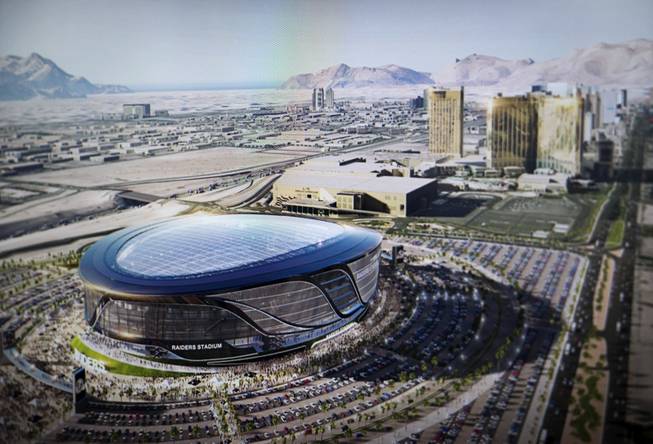
An artist’s illustration of a stadium on Russell Road and Las Vegas Boulevard is displayed on a monitor during a Southern Nevada Tourism Infrastructure Committee meeting at UNLV Thursday, Aug. 25, 2016.
Published Thursday, Sept. 8, 2016 | 6 p.m.
Updated Thursday, Sept. 8, 2016 | 9:30 p.m.
What’s the risk each side of the stadium debate is willing to take?
That question framed much of the Southern Nevada Tourism Infrastructure Committee meeting Thursday afternoon as developers and public leaders tried to inch closer to a proposal that could trigger a recommendation to Gov. Brian Sandoval.
The developers made their intentions clear: They want a public contribution worth $750 million, not one capped at 39 percent of the total project cost. And they rejected any notion of a profit-sharing provision built into the deal.
Las Vegas Sands Corp. officials said those items are non-negotiable in their quest to build a 65,000-seat stadium that could lure the Oakland Raiders here, giving the city its first professional football team and mega-events center. The casino company has partnered with Majestic Realty Co. on the project.
The public’s contribution to the estimated $1.9-billion project likely would be funded through a 0.88-percent hike in the county hotel room tax. The developers and football team would pitch in $650 million and $500 million, respectively, per their proposal.
“I know we’ve been portrayed as difficult,” Sands President Rob Goldstein told the committee. “We’ve tried to present that we are putting private dollars in a public stadium. At the end of the day, we bear the risk.”
The public meeting came a day after some developers and committee members met privately to continue sorting through unresolved issues. But it was clear during Thursday’s meeting that divides remain.
The infrastructure committee members raised concerns about the public’s risks — namely, unknown infrastructure improvements to build a stadium and lackluster economic gain if the stadium projections don’t pan out.
Clark County Commissioner Steve Sisolak, who sits on the committee, said he’d hate to see local entities on the hook for costly roadway improvements to accommodate stadium traffic. He pressed developers for an answer about when those costs might be known but didn’t get a clear-cut answer.
The estimated stadium price tag has grown since the beginning of these conversations, partially because of infrastructure-related variables, Goldstein said. He called the project a “high-risk proposition” for the developers.
“I’m hoping the Russell Road and Bali Hai sites are relatively small numbers as far as infrastructure,” he said.
The public dividends aren’t a given either, considering the revenue and new jobs estimates are based on the stadium hosting 46 events per year, committee members said. Fewer stadium events would mean fewer tax dollars generated.
“There is a risk on the public side as well, which I think is part of the justification for proportional investment,” Chairman Steve Hill said.
Developers, however, didn’t budge on their request to drop the revenue-sharing provision, citing several reasons: They expect their return on investment to be minimal. They’re shouldering construction and operational cost overruns. And they’ve abandoned the idea of pursuing a tax increment financing district.
“What’s a little unfair is the perception somehow that we’re getting a great deal,” Goldstein said.
After more than three hours of discussion, the committee meeting adjourned despite multiple remaining sticking points. Hill asked committee members to send concerns and suggestions to staff members so they can be worked into future drafts of the proposed legislation.
That was after stadium proponents again urged the committee to expedite its process. They want a lawmaker-approved deal by the end of October, allowing time for the Raiders to craft their relocation pitch to the NFL in January.
Still, it’s unclear whether a special legislative session would be feasible, let alone desired by lawmakers, before the general election in November. Legislators offered a mixed-bag of thoughts on the idea when recently queried by the Sun.
“The sooner we can get through this process, the better,” said Andy Abboud, senior vice president of government relations and community development for Sands. “It’s our job to sell it to the Legislature.”
At the beginning of the meeting, committee members approved a recommendation to eliminate a sunset provision from the More Cops tax. The removal would make the tax indefinite, rather than expire in 2025.
The recommendation is part of the committee’s strategy to bolster security on the Las Vegas Strip and downtown. The committee is considering another proposal to increase the county’s sales tax rate by 0.1 percent and then funnel that revenue through a two-tiered distribution model that would first add officers to a defined resort corridor. The remaining revenue would be given to local police agencies, based on population.
The tourism-related committee has until the end of September to forward its recommendations to the governor, who then could call a special legislative session to consider the stadium proposal. The committee meets again Sept. 15.

Join the Discussion:
Check this out for a full explanation of our conversion to the LiveFyre commenting system and instructions on how to sign up for an account.
Full comments policy